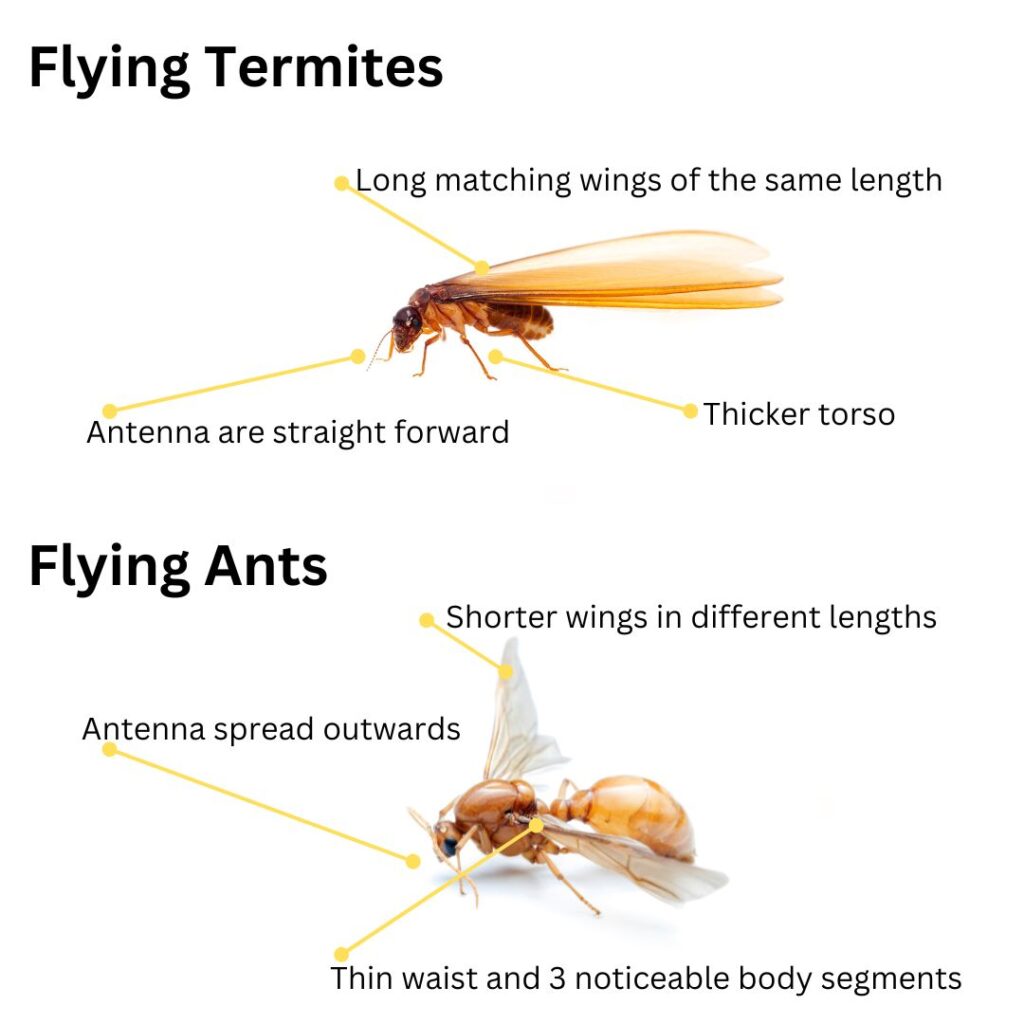Understanding Flying Termites: Essential Insights for Homeowners
Flying termites, commonly referred to as “swarmers,” emerge prominently during seasonal transitions, especially when humidity levels rise, making their presence particularly noticeable in the spring and early summer. During the colder months, these pests remain hidden, quietly consuming wood and expanding their colonies without detection. If you happen to observe these swarmers within your home, it's likely that termite activity has been ongoing for several months, potentially leading to significant structural concerns. Gaining insight into their lifecycle and behavior is crucial for implementing effective termite management and prevention strategies, which are vital for safeguarding your property from these destructive insects.
The combination of rising temperatures and subsequent rainfall often triggers massive swarms of termites, sometimes consisting of tens of thousands of flying individuals. While encountering such a large group can be unsettling, the likelihood of these swarmers establishing a new colony in close proximity is relatively low. These swarmers are naturally drawn to light, which explains their frequent gathering around indoor light fixtures. Understanding this behavior can help you remain calm and take appropriate measures to protect your property from potential infestations, ensuring you stay one step ahead in your termite control efforts.
The Hills District, known for its lush bushland, offers an attractive habitat for termites. As you drive along Windsor Road towards Rouse Hill, you'll likely encounter numerous termite mounds dotting the median strip, serving as a vivid reminder that the surrounding bushland provides ample food sources for these pests. Homeowners in this area should maintain a high level of vigilance, as the close proximity to these natural habitats significantly increases the risk of termite infestations infiltrating residential properties, making proactive measures crucial for long-term protection.
Essential Steps to Take When You Spot Flying Termites
Stay Calm! Your home might not be under immediate termite threat!
Encountering flying termites should prompt you to take protective actions rather than inducing panic or compelling you to purchase expensive termite control systems hastily. Here are several practical measures you can implement to ensure that your home remains well-protected against these pests:
- Schedule Regular Inspections: If it’s been a while since your last professional termite inspection, now is the perfect time to arrange one. Annual inspections conducted by a licensed pest control technician are crucial for identifying potential termite issues early on, ultimately saving you from costly repairs and extensive damage down the line.
- Monitor Weather Patterns: Termites typically swarm on warm, humid nights, making it easier to spot them during these favorable conditions. By staying attentive to changing weather patterns, you can better anticipate their activity and prepare accordingly, increasing your chances of early detection.
- Accurate Identification: Observe the swarmers closely. Do their wings appear to be uniform in size? Are they flying in a distinct ‘swarm’ pattern or scattering aimlessly? Are their antennas straight or bent? Is their body shape consistent, or does it taper towards the waist? While flying ants and flying termites may seem similar, their physical characteristics differ significantly, making accurate identification crucial for effective management and control.

Common Mistakes to Avoid When Handling Flying Termites
While your instinct may be to tackle the issue independently, certain actions could complicate future treatments and exacerbate the termite problem:
- Refrain from Spraying: Although spraying swarmers may eliminate the visible termites, it does not affect the underlying colony and could hinder effective future treatment approaches. It’s essential to address the root cause rather than merely treating the symptoms of an infestation.
- Avoid Sealing Exit Points: If you notice termites emerging from a hole in your walls, do not seal them off. Blocking their exit can force termites to burrow into new areas, potentially leading to increased damage within your home.
- Don’t Disturb Mud Trails: If you encounter mud tubes or trails, resist the urge to disturb them. Interfering with these structures can impede a technician’s assessment and compromise their treatment plan, ultimately worsening the situation and prolonging the infestation.
Assessing the Termite Risk in Your Property
Seeing flying termites does not automatically mean that your home is infested. However, remaining proactive in your pest management efforts serves as a valuable reminder of the importance of vigilance. An annual termite inspection by a qualified professional is your best defense against potential infestations, allowing for early detection and timely intervention. While preventive measures may initially seem like an investment, the costs associated with extensive termite treatment and subsequent repairs can significantly outweigh the expense of routine inspections.
Effective Strategies for Comprehensive Termite Protection in Your Home
Committing to regular annual termite inspections is the cornerstone of a successful pest control strategy. Additionally, adhering to the recommendations provided by your pest control technician for future prevention can further strengthen your protective measures, including:
- Timely refills of your reticulation system to ensure ongoing protection against potential infestations and minimize risks.
- For homes equipped with baiting systems, schedule regular monitoring with your technician to maintain optimal effectiveness and prompt adjustments, ensuring you are always prepared for any potential threats.
- If your property currently lacks a termite barrier, consider investing in one to significantly enhance your defense against possible infestations, providing an additional layer of security for your home.
Taking Timely Action: When to Start Your Termite Prevention Journey
There is no wrong time to begin implementing preventive measures; however, it’s crucial not to wait until you observe swarmers to take action. When flying termites appear, there may already be hidden damage to your property. Initiating preventative steps now can help safeguard your home year-round, ensuring your peace of mind and protecting your valuable investment from potential threats.
At So Pest Off, we are dedicated to empowering you with informed, proactive choices regarding termite protection, steering clear of scare tactics.
Contact us for reliable inspections and effective, transparent solutions tailored to your specific needs.
The post Flying Termites: Explore This Essential Action Plan appeared first on https://writebuff.com.
The Article Flying Termites: Your Essential Action Plan for Control Was Found On https://limitsofstrategy.com


It’s fascinating to delve into the world of flying termites, particularly how their lifecycle aligns so closely with seasonal changes. I remember a few years back, my family experienced a sudden influx of swarmers in our attic during a particularly humid spell in early summer. At first, we were entranced by the spectacle, watching these tiny creatures dance through the air, but the excitement quickly turned to anxiety when we began to research the implications of their presence.
It’s fascinating how these flying termites, or swarmers, can be indicators of hidden issues in our homes. I recently learned that they’re not just a spring nuisance but also a remarkable part of the ecosystem, playing a role in breaking down dead wood and recycling nutrients back into the soil. However, their dual nature as both beneficial and destructive makes it essential for homeowners to stay vigilant.
Your insights on flying termites and their lifecycle really underscore the importance of vigilance, especially for homeowners in regions prone to humid conditions. It’s indeed alarming how these pests can remain undetected for months while silently damaging one’s property. I’ve experienced this firsthand; a friend of mine discovered significant termite damage in her attic only after noticing the swarmers indoors. The situation escalated quickly, requiring extensive repairs that could have been avoided with earlier detection.
It’s definitely concerning how pests like termites can fly under the radar for so long. Your friend’s experience really highlights the importance of being proactive. I’ve heard that in humid areas, regular inspections can make such a difference. A neighbor of mine started using sensors that detect early signs of termite activity, which seems like a smart way to stay ahead of potential damage.
Speaking of vigilance, I’ve recently come across some really helpful insights on caring for senior dogs that stress the importance of being attentive to their changing needs.
‘The Ultimate Guide to Caring for Your Senior Dog: Tips and Best Practices’
https://arquiaca.org/the-ultimate-guide-to-caring-for-your-senior-dog-tips-and-best-practices/.
You’ve made a great point about being proactive, especially in areas prone to termite activity. The idea of using sensors is quite innovative and seems like a worthwhile investment. It’s interesting how technology is bridging the gap in so many areas of home maintenance. I’ve heard about similar advancements in pest control that employ smart technology to monitor conditions that attract pests, helping homeowners take preventive measures sooner rather than later.
You’ve touched on something really exciting here. The integration of technology into home maintenance feels like a game-changer. With termite sensors and other smart solutions, it’s not just about addressing problems when they arise, but actively monitoring and preventing them before they escalate. It’s all about giving homeowners that peace of mind, knowing they can stay ahead of potential threats.
You’re right about the importance of being proactive with pest control, especially when it comes to something as stealthy as termites. It’s a bit staggering how much damage they can cause before you even realize they’re there. I’ve heard good things about those early-detection sensors, too. Using technology to catch issues before they escalate seems like a smart, forward-thinking approach. It kind of parallels what we often advocate for in personal health, right? Regular check-ups and preventative measures can prevent problems down the line.
Sounds like your friend’s attic had a secret party, and the termites were the uninvited guests that just wouldn’t leave. It’s wild how these winged nuisances can turn a peaceful home into a horror show. It’s like they have a built-in “Surprise! We’re here to munch your wood!” alert that only triggers when you’re totally unprepared.
“To help homeowners stay ahead of these hidden threats, check out our tips and resources on effective termite prevention and early detection strategies.”
https://arquiaca.org/WildSurvive
You’ve touched on a crucial aspect of dealing with termites: the insidious nature of their damage. It’s so unsettling how they can go unnoticed for an extended time while quietly working away at the structure of a home. The experience your friend went through is a stark reminder of why being proactive is key.
I appreciate the depth of information you provided about flying termites and their lifecycle. It’s alarming to think about how much damage they can cause while remaining hidden during the colder months. I’ve had a friend battle a termite infestation in their home, and it was eye-opening to see the extent of the destruction, even when everything looked fine on the surface. It really makes you realize the importance of regular inspections, especially after heavy rains. Have you come across any effective DIY methods for prevention or signs we should look for beyond just spotting those swarmers? It seems like even small proactive steps can make a big difference in safeguarding our homes.
It’s definitely eye-opening to see how insidious termites can be. Your friend’s experience really highlights how they can cause serious damage, often without any obvious signs until it’s too late. I’ve read that regular inspections are crucial, especially after heavy rains when they might be more likely to venture out in search of new homes.
You’re spot on about termites being little ninjas of destruction. They can go from zero to demolition in no time, all while we’re blissfully unaware, sipping our morning coffee. It’s like they have a secret life that’s all about munching wood and building a condo in your walls.
It’s really something, isn’t it? Those quiet little wood munchers can wreak havoc before we even know they’re around. Your friend’s experience must have been a real eye-opener, and it’s a great reminder that what we can’t see can definitely hurt us—especially when it involves our homes.
It’s really eye-opening to hear about your friend’s experience with termites; it highlights how insidious they can be. I think a lot of people associate pest problems with visible signs, but as you pointed out, the damage can often be lurking beneath the surface. Regular inspections really do seem to be key, especially after heavy rains which can create conditions perfect for many pests, including termites.
It’s fascinating how these unseen threats can impact our homes, isn’t it? Your reflection on visible signs versus what’s hidden really strikes a chord. It’s almost like having a shadow partner in crime that we’re not even aware of until it’s too late. My friend’s experience with termites opened my eyes to just how crucial it is to stay vigilant. It’s surprising how a lot of people don’t realize how much damage these little insects can do behind the scenes.
It really is fascinating how these unseen threats can quietly compromise our homes and lives. Your mention of termites struck a chord with me too. I had a friend who went through a tough time dealing with a termite infestation. They didn’t notice anything until the damage was significant. It made me realize how often we neglect these hidden dangers.
You’re spot on about those unseen threats. It’s often the hidden issues that can have the biggest impact on our lives without us even realizing it. Your friend’s experience with termites really highlights a crucial point—many of us just don’t think about what’s happening beneath the surface, whether it’s in our homes or in other areas of our lives.
“Absolutely, it’s eye-opening how easily these hidden threats can take hold! If you’re looking to safeguard your home from such dangers, check out these expert tips and resources.”
https://arquiaca.org/ChocolateHealth
It really is interesting how these hidden threats can slip under our radar, isn’t it? Your friend’s experience with termites highlights a common challenge. Often, we tend to focus on what we can see – things like leaky roofs or broken windows – while the silent damage is happening out of sight. Regular home inspections can catch these issues early. It’s like a health check-up for your house. Plus, small adjustments, like keeping wood away from damp areas, can really help. It’s a small effort for peace of mind. What do you think could be the best way to raise awareness about these often-ignored problems?
“I completely agree! It’s surprising how easily we can overlook these issues. If you’re interested in learning more about detecting and preventing such hidden threats, check out this helpful resource.”
https://arquiaca.org/LightCam
You hit the nail on the head with the whole visibility thing. It’s so easy to think you’d notice if something was wrong, but pests like termites really do have a knack for hiding out until they’ve done a good bit of damage. I know a couple of folks who faced some pretty hefty repair bills because they didn’t catch the problem in time. It’s wild how a little bit of wood can turn into a big headache if you’re not paying attention.
It’s wild how much damage termites can do while they’re lurking out of sight, right? Your friend’s experience really highlights the hidden risks in our homes. Regular inspections are definitely key, especially after heavy rains when termites can become more active.
You’ve touched on a crucial point that many people overlook until it’s too late. The hidden nature of termites can be incredibly deceptive; they can wreak havoc without any obvious signs, which is why regular inspections are so vital, especially after rainy periods when they might be more active.
“Absolutely, taking proactive steps can really help in safeguarding your home! If you’re interested, I’ve included a helpful guide on effective DIY prevention methods and signs to watch for, which might just give you the edge against these hidden threats.”
https://arquiaca.org/LightCam
It’s really interesting how flying termites, or swarmers, can be such an indication of a larger problem happening right under our noses—quite literally! I’ve always found it fascinating (and a bit unsettling) that these pests can go undetected for months because their initial presence seems harmless or even a bit enchanting when you first spot them swarming outside.